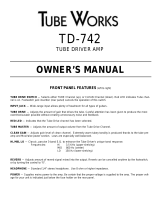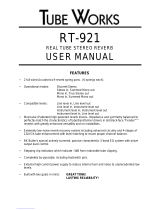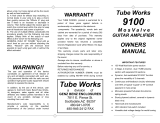Page is loading ...

OWNERS MANUAL
FEATURES:
• Ultra Light 26.5 lb Compact Design • Class D Power Amplication Technology
• Two Pre Amp Channels • Custom 12” Loudspeaker and Compression Bullet Tweeter
• Input Phase Reverse Switch • Compact Monitor Shaped Cabinet Design
• 24-Bit Studio Quality Digital Effects • Speaker Stand Mountable
• Phantom Power • Lightweight 9 Ply Plywood Construction
PRODUCT DESCRIPTION – The Shenandoah™ Acoustic 150 LT is congured as a 2 channel – 4 input
150/200 watt acoustic instrument amplier. Each channel is equipped with both a ¼” unbalanced line input and an
XLR balanced microphone input (with phantom power). The 2 inputs on each channel are summed (mixed) together
at a 1:1 ratio. Each channel then passes through independent 3 band equalizers with a sweepable midrange
frequency. Equalization centers were carefully selected for use with acoustic instruments. Each channel also
contains individual send controls to the on-board 24-bit 15 program digital effects circuit. The channel signals are
then summed together, mixed with the digital effects return and passed on to the internal power amplier. The back
panel contains 3 direct balanced outputs with ground lift switch, 3 unbalanced line outputs, an effects loop, effects
cancel jack, and two-1/4” speaker jacks.
1

FRONT PANEL
INPUTS – The Shenandoah™ Acoustic 150LT is equipped with 2 types of input jacks. The ¼” input is unbalanced
and “line level” with a usable sensitivity from 100 mV to 1.6 volt. The input impedance is 270k ohms. The ¼” input will
also accept most active balanced line sources. Automatically unbalancing them by recognizing the tip portion of the
balanced signal. If an instrument offers an unbalanced output it should be connected to the unbalanced input of the
Shenandoah amp. Additionally, the precision input scaling preamp contains a 45 Hz, 12 dB/octave high pass lter
(more effective and less intrusive than the more common 6 dB lters) and an “RFI” lter (radio frequency interference)
to eliminate unwanted noise. The XLR input jack is balanced and “microphone level”, with a usable sensitivity from
-60dBv to -30 dBv. It is not a line level input. It contains a precision full range differential microphone preamp with
phantom power. For use with higher-level sources (such as the balanced line level output from a keyboard or other
instruments), a balanced pad network will be necessary to use the balanced input. For instance, a Rapco, “Pad Blox”,
-20 or -30 pad or similar product could be used.
INPUT CLIP LED – The Red Clip LED senses the input signal to the preamp section and warns of input
overload. For the cleanest signal possible this LED should only ash with the strongest signal peaks. Adjust this
sensitivity with the preamp volume control.
COMBINING XLR & ¼” INPUTS – A unique feature of the Shenandoah™ Acoustic 150LT is the ability to mix
the XLR balanced and ¼” unbalanced inputs on each channel. In many situations, this effectively makes the
amplier function as a 4 channel amplier. The most effective way to use this feature is to set the volume on the
channel using the XLR microphone input and then adjust the level control on the instrument itself (assuming that it has
one) to blend levels between the 2 inputs. Equalization will be common to both inputs on the channel.
PHASE SWITCH – Each channel is provided with a phase reverse switch. By reversing the phase of the input
signal, feedback tendencies can be reduced if caused by sympathetic vibrations between the speaker and the
instrument. Under some conditions, changing the phase can drastically improve the output from the amplier and can
improve the playability of some instruments.
ON-BOARD STUDIO QUALITY DIGITAL EFFECTS – The Shenandoah™ 150LT contains a studio
quality 24-bit, 15 program digital effects processor. We chose to use an industry leader in digital processing for realis-
tic, high quality effects algorithms. Level differences are normal when switching between different effects; just adjust
the channel send and master level controls accordingly. The effects level control on each channel adjusts the send
level to the digital effects processor. The digital effects level in the master section controls the effects return level from
the processor. In general, turning up the channel effects send will yield lusher effects response. Running the channel
effects send lower and the master level higher will yield softer effects response.
PROGRAM DESCRIPTIONS
2
NAME DESCRIPTION
Hall 1 Bright hall reverb
Hall 2 Warm hall reverb
Room 1 Hardwood studio reverb
Room 2 Ambient room reverb
Room 3 Warm room reverb for guitars and rhythm instruments
Plate 1 Classic plate reverb for lead vocals and instruments
Plate 2 Sizzling bright plate reverb for vocals
Plate 3 Short “vintage” plate reverb
Chorus Chorus (Tonal variations in pitch and volume)
Flange Flanger for jet wash effects
Delay 1 125ms slapjack delay
Delay 2 190ms slapjack delay
Chorus/Plate Chorus with reverb plate
Chorus/Room Auto-wah guitar effect with reverb
Bypass No effect
Pitch Shift Rotary Rotary speaker emulation

BACK PANEL
DIRECT OUTPUTS – The Shenandoah™ Acoustic 150LT. contains the most comprehensive direct output sec-
tion available on any acoustic instrument amplier. Both XLR balanced and ¼” unbalanced outputs make “real world
sense” when connecting with other equipment. The ¼” unbalanced outputs are true professional line level (+4 dBv)
with an output impedance of 1k ohm and can drive virtually any line level input, including power ampliers. The XLR
balanced output is “hot” mic level, rated at –30 dBv. This conguration allows the Shenandoah™ Acoustic 150LT
to drive very long cable lengths (250+ feet) without problems or added noise. The XLR balanced direct outputs can
be “ground lifted” with the global ground lift switch. This switch lifts pin 1 on all of the XLR balanced outputs to break
ground any loops between the Shenandoah™ Acoustic 150LT and a PA system. Separate Channel 1 and Channel
2 outputs are post channel volume/pre EQ/pre effects (to take advantage of the dual inputs on each channel) while
the Channel 1+2 output is post master volume/post eq/post effects to aid in sending a “nished” mixed signal to a PA
system or external power amplier.
3
ACTIVE EQUALIZATION – The Shenandoah™ 150LT offers a 3 band (with sweepable mid) active equalizer
for each channel. These equalizers, similar to those found on professional sound consoles, are very useful tools when
used correctly.
LOW FREQUENCY EQ - The corner frequency of the low frequency section is 125 Hz, shelving curve. This fre-
quency is particularly handy when dealing with low frequency feedback from a big dreadnaught guitar. A combination
of volume reduction and turning down the low frequency control will generally get good results. Become familiar with
the action of the controls since their effective gain range is quite large. The low frequency control is also handy for
adding some “bottom” to a baritone sax and “chunk” to a mandolin or mando-cello.
HIGH FREQUENCY EQ - The corner frequency of the high frequency section is 8 kHz, shelving curve. This
frequency is especially useful for taming the bright harshness of some mandolins, violins, brass, and reeds. It can also
be used to help acoustic guitars, cellos, and utes cut through other players in loud club situations.
MID FREQUENCY EQ - The “sweepable mid” section features 15 dB of cut or boost with a bandwidth approxi-
mately 1 octave wide. The center frequency of this lter is continuously user adjustable from 250 Hz to 5 kHz with
a single control. This lter is typically (but not always) used to reduce or remove offending frequencies in the instru-
ment’s pick-up response. Removing only the minimum amount necessary will yield the most acoustically rewarding
results. The easiest and most repeatable way to determine the offending frequency range is to boost the mid level
somewhat (but not to the point of feedback) and while playing, sweep the frequency control slowly across its range.
You may need a third hand until it becomes second nature, but soon you will nd out just how quick it can be. You will
hear a clear and obvious accentuation of the ugliness you want to remove. The ear is a most sensitive and discrimi-
nating piece of test equipment when used in this manner, another good reason to protect them! This is the way many
touring sound engineers equalize, since it is quick, accurate and repeatable. Occasionally, you will nd need to use
the mid section in “boost” mode, particularly common when adding higher mids (bite) to an otherwise dull instrument,
or adding low mid “body” to an otherwise thin sound. Spend some time experimenting so that the process becomes
creative as well as corrective.
It may be helpful to know - the 9 o’clock position is 300 Hz, the 12 o’clock position is 1.25 KHz and the 3 o’clock
position is 3 KHz.
MASTER VOLUME – The master volume control adjusts the overall volume of channel 1, channel 2, and the
effects return (either on-board or out-board). Typically, best results are obtained when this control is operated between
the 9 o’clock and 3 o’clock positions.

4
EFFECTS LOOP—A serial effects loop is provided so an out-board effects processor can be used with or in
place of the on-board Digital Effects unit. The return level from an external processor into the ¼” effects return jack
should be adjusted using the controls of the external processor. The on-board effects can be turned off by using the
effects cancel jack, turning down the effects levels or using the program labeled “bypass”. All other on-board effects
on the Shenandoah™ Acoustic 150LT can be used in conjunction with an out-board effects unit plugged into the
effects loop.
EFFECTS CANCEL JACK - A ¼” effects cancel jack is provided on the back panel to mute the internal
effects via footswitch. Any standard single button latching footswitch (with shielded cable) may be used. Signal is
muted when the switch is closed.
SPEAKER OUTPUT JACKS – The Shenandoah™ Acoustic 150LT provides 2 parallel ¼” speaker output
jacks. Minimum total load is 4 ohms (2 x 8 ohm speaker cabinet). The Shenandoah™ Acoustic 150LT is factory
equipped with our GBE 1230, 12” speaker and a compression bullet tweeter presenting an 8 ohm load to the
amplier.
POWER AMPLIFIER – The power amplier used in the Shenandoah™ Acoustic 150 LT is a super-efcient
class D pulse width modulation amplier which produces almost no waste heat. This ultra light amplier technology
offers unparalleled performance and power and is the heart of the lightweight Shen 150LT.
POWER INPUT – The Shenandoah™ Acoustic 150 LT is shipped from the factory with a standard IEC type
power inlet connector and the appropriate detachable power cable for the market the amplier was shipped to. The
power input section of the Shenandoah™ Acoustic 150 LT is auto-conguring and will adapt to any input voltage
from 100 – 240 volts without any adjustment by the user. The AC mains fuse (with a spare fuse included) is located
in the small slide out tray on the lower portion of the IEC power inlet connector. Always replace with the correct
value fuse as indicated on the rear panel of the amplier. The fuse value is the same for all input voltages and is
only needed to protect the primary wiring.
The power supply inside the chassis of the Shenandoah™ Acoustic 150 LT is a highly sophisticated
auto-conguring switch mode power supply (SMPS). This class of supply does the energy conversion through a
very efcient process which contributes to the light weight of the Shen 150LT. The power supply itself is internally
protected and fused against catastrophic faults.
PHANTOM POWER – An internal phantom power source (12 volts) is provided for use with condenser mics.
This power source is on at all times and does not affect the standard operation of the amp, even when a condenser
mic is not used. We use the DIN 45-596-P12 volt standard which will operate virtually all of the live sound
reinforcement condenser microphones on the market. Some “boutique” externally biased condenser mics will not
be compatible and will require 48 volt phantom power. We suggest live sound condenser mics by: AKG, Audio
Technica, CAD, Shure and Crown.
TWEETER LEVEL CONTROL – The “rocker switch” tweeter level control provides three positions for
additional acoustic exibility. The positions are: On, Off and –6 dB.
MONITOR SHAPED CABINET DESIGN – This cabinet design offers two platforms so the cabinet can be
used in the normal upright position or tipped back towards the performer for more of a monitoring situation. Leaning
the cabinet back can change the tone of the amp and reduce boomy low frequencies.
SPEAKER STAND MOUNT – A 1 1/2” speaker stand mount is provided for use with a speaker stand.

SHENANDOAH™ ACOUSTIC 150LT
ENGINEERING SPECIFICATIONS
INPUTS
XLR Balanced input impedance: 2.2 k ohms
XLR Balanced input sensitivity: -60 to –30 dBV
¼” Unbalanced input impedance: 270 k ohms
¼” Unbalanced input sensitivity: -18 to +4 dBV
AMPLIFIER OUTPUT
Power at 8 ohm load: 150 watts RMS
Power at 4 ohm load: 200 watts RMS
THD + N (preamp): <0.02%
THD + N (power amp): <0.05%
Frequency response: 20 Hz – 20 kHz +/- 1dB
CHANNEL EQUALIZATION
Low frequency: 125 Hz shelving, +/-15dB
Mid frequency (sweep): 250 Hz – 5 kHz , peaking, +/-15dB
High frequency: 8 kHz shelving, +/-15dB
DIRECT OUTPUTS
XLR balanced output level: -30 dBV nominal
XLR balanced output impedance: 150 ohms
¼” unbalanced output level: +4 dBV nominal
¼” unbalanced output impedance: 1 k ohm
EFFECTS LOOP
¼” unbalanced output level: -10 dBV
¼” unbalanced output impedance: 1 k ohm
¼” unbalanced input level: -10 dBV
¼” unbalanced input impedance: 47 k ohm
¼” effects cancel jack: short T-S cancels return
DIGITAL EFFECTS
Processor type: WaveFront™ DSP engine
Internal processing: 24 bit
A/D converter: 24 bit – 64X oversampling
D/A converter: 24 bit – 128X oversampling
Dynamic Range: 80 dB
THD + N (1 kHz): <0.01%
Sampling rate: 48 kHz
5

Declaration of Conformity
(89/336 EEC-EMC Directive)
Manufacturer’s Name: Genz Benz, a division of KMC Music Corp.
Manufacturer’s Address: 7811 East Pierce Street
Scottsdale, AZ 85287, U.S.A.
Product Type: Audio Amplier
Model Number: Shenandoah™ Acoustic 150 LT (all versions)
Operating Power Condition: 100/115/230/240 V, 50/60 Hz
Effective Date: 01-01-2007
Conforms to the Following Standards: [X] EN 55013: 2001 + A1: 2003
[X] EN 55020: 2002 + A1: 2003
[X] EN 60065: 2001 + A1
[X] IEC 61000-3.2: 2000
[X] IEC 61000-3.3: 1994 + A1: 2001
[X] IEC 61000-4.2
[X] IEC 61000-4.3
[X] IEC 61000-4.4
[X] FCC 15.107 and 15.109
[X] RoHS Directive 2002/95/EC
[X] WEEE Directive 2002/96/EC
[X] CE Mark LV Directive 73/23 EEC
A KMC Music Corp. Bloomeld, CT
7811 E. Pierce Street, Scottsdale, AZ 85257
PH: 480-941-0705 FAX: 480-946-2412
www.genzbenz.com
6
REV 5
SAFE OPERATING REQUIREMENTS:
• Never set an amplier on anything that will tip over or collapse under its weight.
• Provide a minimum distance of 25.4 mm (1 inch) around all sides of the amplier for sufcient ventilation. The ventilation should not be
impeded by covering the amplier’s vent openings with items such as newspapers, table-cloths, curtains, etc.
• No naked ame sources, such as lighted candles, should be placed on the Shenandoah™ Acoustic 150 LT amplier.
• This amplier should not be exposed to dripping or splashing and no objects lled with liquids, such as vases or drinks, shall be placed on
this product.
• The Shenandoah™ Acoustic 150 LT amplier should be connected to a mains socket outlet (power receptacle) with a protective earth
(ground) connection at all times.
• The ampliers mains plug (power plug) is considered the disconnect device and the connection must remain accessible at all times.
• This amplier is capable of producing sound pressure levels that may cause hearing loss.
• There are no user serviceable parts and hazardous operating voltages inside this unit. Always consult a qualied repair facility for service.
WARNING!
• The use and operation of this device constitutes an agreement of full release of any and all liability connected with it’s use. Only persons
familiar with the operation of high-powered professional audio equipment should attempt to operate this device.
• In addition, by use of this device, the user agrees to hold Genz Benz and its designers, sales agents, and all other afliates and related parties
harmless in the event of any accident, injury, damage or loss resulting from such use.
• Manufacturer’s sole responsibility is to provide a warranty on the specied performance of the product under normal operating conditions
for a period of 3 years.
WARRANTY:
• Genz Benz warrants the model Shenandoah™ Acoustic 150 LT to be free from defects in materials and workmanship for a period of 3 years
from the date of purchase, when purchased from an authorized Genz Benz dealer.
• This warranty does not cover normal wear and tear incurred from the normally designed use of the product.
• This warranty is effective only if a copy of the original sales receipt is presented at the time of warranty service
• This limited warranty is completely transferable to any subsequent buyer as long as the original sales receipt is also transferred to subsequent
buyer.
• All warranty service must be performed by a Genz Benz authorized service center.
• Before returning any unit for service, a returned merchandise authorization number (RMA#) must be obtained by calling 480-941-0705
• For all products sold outside the USA, warranty is handled through our international distributor for each country.
For more information visit our website www.GENZBENZ.com
/




